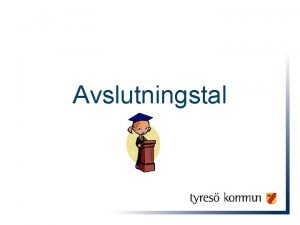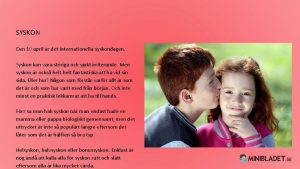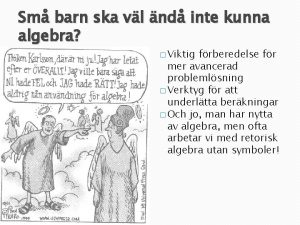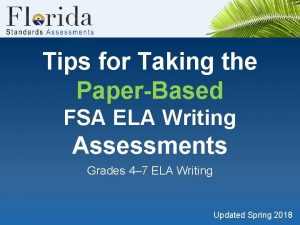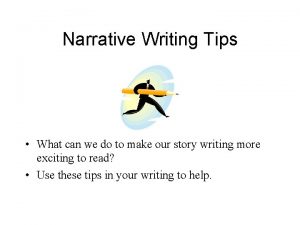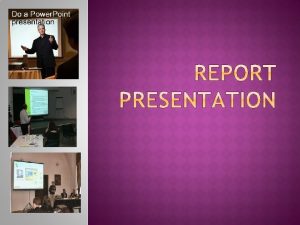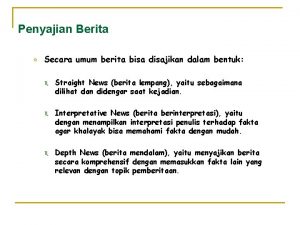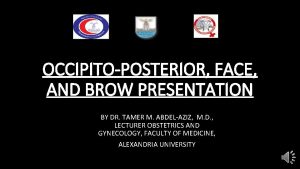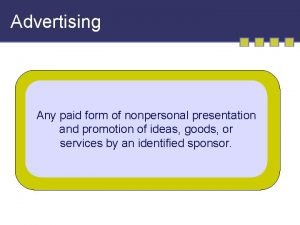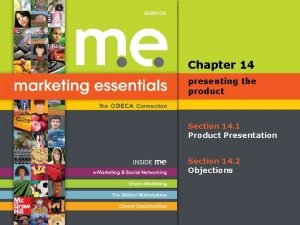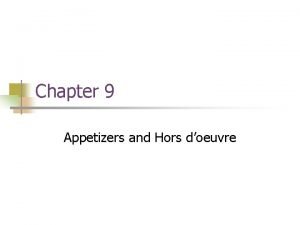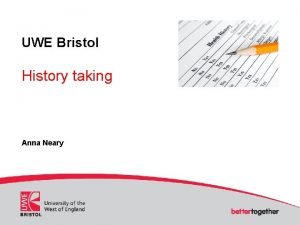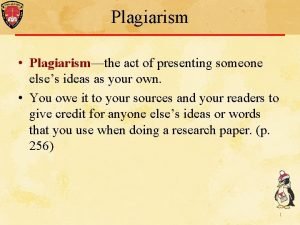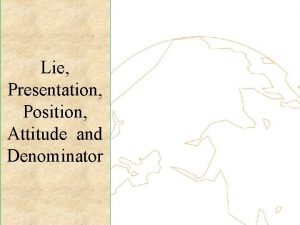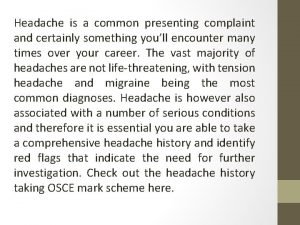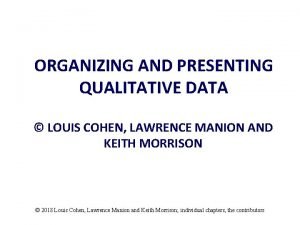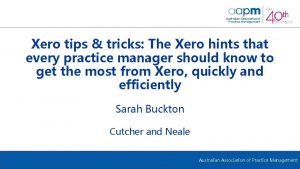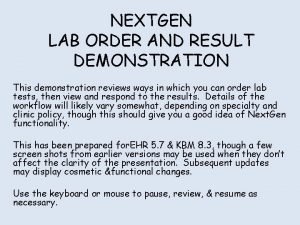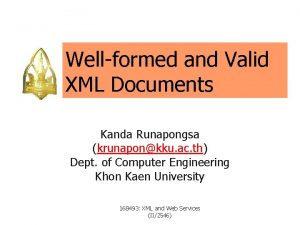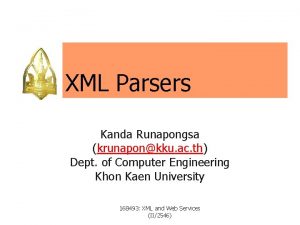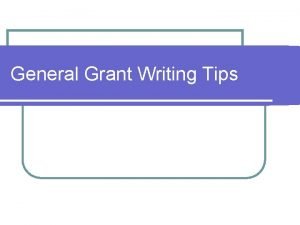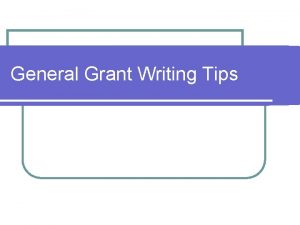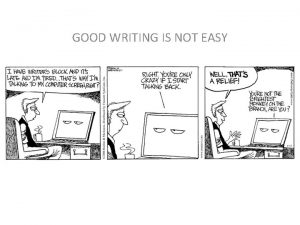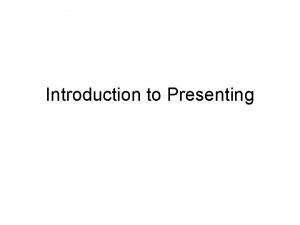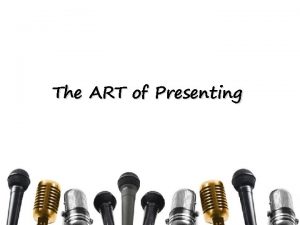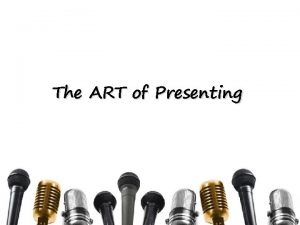Tips in Writing and Presenting Information Kanda Runapongsa




















































- Slides: 52

Tips in Writing and Presenting Information Kanda Runapongsa (krunapon@kku. ac. th) Dept. of Computer Engineering Khon Kaen University 168493: XML and Web Services (II/2546)

Suggestions in Writing Do not use the word “Data”, “Basic Knowledge”, “Acknowledge” to represent background information n Use “Background” for the section that includes the background information of the work n Make a reference to theory that is belong to others n 168493: XML and Web Services (II/2546) 2

Suggestions in Writing (Cont. ) n Do not forget articles: ‘a’, ‘an’, ‘the’ Wrong: Design and querying database n Right: Design and querying a database n n Avoid needless words Redundant: There is a car coming to the Computer engineering department n Improved: A car is coming to the Computer engineering department n 168493: XML and Web Services (II/2546) 3

Guides for Effective Sentences Avoid the overuse of short, choppy sentences n Avoid needless separation of related parts of a sentence n Avoid dangling modifiers n Use parallel structure to express ideas of equal importance n Avoid needless shift n 168493: XML and Web Services (II/2546) 4

Avoid Short & Choppy Sentences n A short, simple sentence can be forceful n n Thailand won the Sea games. But a long string of short sentences usually produces a childish effect n I walked through the wood. I saw a squirrel. It darted up a tree. 168493: XML and Web Services (II/2546) 5

Avoid Short & Choppy Sentences The ideas that would otherwise appear in separated sentences can usually be effectively combined n The combination can be used to n Show their relative importance n Show their relationship to each other n 168493: XML and Web Services (II/2546) 6

Coordination The simple sentences can be regarded as independent clauses n They can be joined by a coordinate conjunction to form a compound sentence n Examples of conjunctions n n But, and, so, thus, or, nor, yet 168493: XML and Web Services (II/2546) 7

Example 1: Coordination Sentences: The princess had many dresses. She cared for none of them. n Result: The princess had many dresses, but she cared for none of them. n 168493: XML and Web Services (II/2546) 8

Example 2: Coordination Sentences: Mullins had been tricked once. He didn’t want to be tricked again. n Result: Mullins had been tricked once, and he didn’t want to be tricked again. n 168493: XML and Web Services (II/2546) 9

Example 3: Coordination Sentences: Jack had nothing to do. He went to the movies. n Result: Jack had nothing to do, so he went to the movies. n 168493: XML and Web Services (II/2546) 10

Compounding Simple sentences in which the same word or group of words is used in the same way can be combined n The combination can be done by eliminating the repetition through compounding the verb or the subject n 168493: XML and Web Services (II/2546) 11

Examples: Compounding Sentences: We put up the tent. We fell asleep at once. n Result: We put up the tent and fell asleep at once. n Sentences: Carol is learning to play bridge. I am learning to play bridge. n Result: Carol and I are learning to play bridge. n 168493: XML and Web Services (II/2546) 12

Subordination One idea or the other can be given less emphasis by making it into a dependent clause n This method usually expresses the relationship between the ideas more clearly than coordination or compounding n 168493: XML and Web Services (II/2546) 13

Examples: Subordination Sentences: He heard the news. He was elated. n Result: When he heard the news, he was elated. n Sentences: He had failed twice before. He was not discouraged n Result: Although he had failed twice before, he was not discouraged. n 168493: XML and Web Services (II/2546) 14

Examples: Subordination Weak: He jumped seven feet, breaking the world’s record n Improved: Jumping seven feet, he broke the world’s record n Sentences: The car wouldn’t start The engine was flooded. n Improved: The car wouldn’t start because the engine was flooded. n 168493: XML and Web Services (II/2546) 15

Reduction Whenever possible, eliminate unnecessary words by n Reducing clauses to phrases n Reducing phrases to single words n 168493: XML and Web Services (II/2546) 16

Examples: Reduction Clause: Because he was discouraged about writing stories, Eric decided to try nonfiction. n Phrase: Discouraged about writing stories, Eric decided to try nonfiction. n 168493: XML and Web Services (II/2546) 17

Examples: Reduction Clause: The man who is holding the pistol is the starter. n Phrase: The man with the pistol is the starter. n Clause: The fans booed the decision of the umpire. n Word: The fans booed the umpire’s decision. n 168493: XML and Web Services (II/2546) 18

Avoid Needless Separation Subject and verb should not be separated unnecessarily n Example: n Wrong: I, hoping very much to see him, hurried. n Right: Hoping very much to see him, I hurried. n 168493: XML and Web Services (II/2546) 19

Avoid Needless Separation Adverbs should be place near the word they modify n Example: n Wrong: We only worked for two hours. n Right: We worked only two hours. n 168493: XML and Web Services (II/2546) 20

Avoid Needless Separation Phrases should be near the word they modify n Wrong: Notify us if you can come on the enclosed card. n Right: Notify us on the enclosed card if you can come. n 168493: XML and Web Services (II/2546) 21

Avoid Needless Separation Phrases should be near the word they modify n Wrong: The little girl stood beside the horse in a blue dress. n Right: The little girl in a blue dress stood beside the horse. n 168493: XML and Web Services (II/2546) 22

Avoid Needless Separation Clauses should be near the words they modify n Wrong: She put a hat on her head which she had just bought. n Right: She put on her head a hat which she had just bought. n 168493: XML and Web Services (II/2546) 23

Avoid Needless Separation Clauses should be near the words they modify n Wrong: He bought a car from his friend that had a defective motor. n Right: He bought from his friend a car that had a defective motor. n 168493: XML and Web Services (II/2546) 24

Avoid Splitting of Infinitives: to + Verb n Wrong: I asked her to occasionally visit me. n Right: I asked her to visit me occasionally. n 168493: XML and Web Services (II/2546) 25

Avoid Dangling Modifiers A modifier is said to dangle when there is no word in the sentence that it can sensibly modify. The error can be corrected n (1) by adding a word that the modifier can modify n (2) by expanding the modifying into a subordinate clause n 168493: XML and Web Services (II/2546) 26

Avoid Dangling Modifiers Dangling Participle n Wrong: Flying over the Alps, the views were spectacular. n Right: Flying over the Alps, we saw spectacular views. n Right: When we flew over the Alps, the views were spectacular. n 168493: XML and Web Services (II/2546) 27

Avoid Dangling Modifiers Dangling Gerund Phrases n Wrong: After walking for hours, the cabin was found by the hikers. n Right: After walking for hours, the hikers found the cabin. n 168493: XML and Web Services (II/2546) 28

Avoid Dangling Modifiers Dangling Infinitive n Wrong: To be well cooked, you must boil beefs a half hour. n Right: To be well cooked, beefs must be boiled a half hour. n 168493: XML and Web Services (II/2546) 29

Avoid Dangling Modifiers Dangling Elliptical Clause n Wrong: When a little girl, my uncle took me to a circus. n Right: When a little girl, I was taken by my uncle to a circus. n 168493: XML and Web Services (II/2546) 30

Use Parallel Structure Use parallel structure to express ideas of equal importance n Wrong: She is slender, with blue eyes, and has a friendly manner. n Right: She is slender, blue-eyed, and friendly. n 168493: XML and Web Services (II/2546) 31

Use Parallel Structure Wrong: He likes hiking and to fish n Right: He likes hiking and fishing n Right: He likes to hike and to fish n Wrong: I like to go jogging and shop n Right: I like jogging and shopping n Right: I like to go jogging and then go shopping n 168493: XML and Web Services (II/2546) 32

Avoid Omitting Unnecessary Words In comparison or degree, avoid omitting unnecessary words n Wrong: I was so tired. n Right: I was so tired that I fell asleep n Wrong: Salaries of supervisors are higher than workmen n Right: Salaries of supervisors are higher than those of workmen n 168493: XML and Web Services (II/2546) 33

Avoid Needless Shift in person n Wrong: When you are healthy, one should be thankful n Right: When you are healthy, you should be thankful n Right: When one is healthy, he should be thankful n 168493: XML and Web Services (II/2546) 34

Avoid Needless Shift in Number n Wrong: If a person works hard, they will succeed n Right: If a person works hard, he will succeed n Right: If people work hard, they will succeed n 168493: XML and Web Services (II/2546) 35

Avoid Needless Shift Avoid needless shift in subject or voice of verb n Wrong: Laughter could be heard as we approached the house n Right: We heard laughter as we approached the house n 168493: XML and Web Services (II/2546) 36

Avoid Needless Shift Avoid needless shift in subject or voice of verb n Wrong: Marilyn lived by the lake, and many hours were spent in the swimming n Right: Marilyn lived by the lake and spent many hours in swimming n 168493: XML and Web Services (II/2546) 37

Avoid Needless Shift in Tense n Wrong: She sat down by the fire and begins to knit n Right: She sat down by the fire and began to knit n 168493: XML and Web Services (II/2546) 38

Avoid Needless Shift in Mood n Wrong: Finish your work, and then you should rest n Right: Finish your work and then rest n Right: You should finish your work, and then you should rest n 168493: XML and Web Services (II/2546) 39

Avoid the Double Negative The word hardly and scarcely are negative in meaning: they should be used with not: n Wrong: I can’t scarcely hear him n Right: I can’t hear him n 168493: XML and Web Services (II/2546) 40

Use the Active Voice The active voice is usually more direct and vigorous than the passive voice: n Weak: My first visit to Boston will always be remembered by me n Improved: I shall always remember my first visit to Boston n 168493: XML and Web Services (II/2546) 41

Use the Active Voice Weak: The reason that he left college was that his health became impaired n Improved: Failing health compelled him to leave college n Weak: There were a great number of dead leaves lying on the ground. n Improved: Dead leaves covered the ground n 168493: XML and Web Services (II/2546) 42

Use the Positive Form Make definite assertions n Avoid tame, colorless, hesitating, non -committal language n The reader is dissatisfied with being told only what is not; he wishes to be told what is n Weak: he was not very often on time n Improved: He usually came late n 168493: XML and Web Services (II/2546) 43

Use the Positive Form Weak: he did not think that studying Latin was much use n Improved: He thought that the study of Latin useless n Not honest dishonest n Not important unimportant n Did not remember forget n Did not pay attention to ignore n 168493: XML and Web Services (II/2546) 44

Organizing a Paragraph n n n Make the paragraph the unit of composition: one paragraph to each topic Each paragraph should begin with topic sentence (the sentence that tells the main idea of the paragraph) The final sentence either emphasizes the thought of the topic sentence or states some important consequence 168493: XML and Web Services (II/2546) 45

Suggestions in Presenting n Use the font size large enough to be seen by the audience n n Do not use too small font sizes Use a well-contrasted text and background colors Use a dark text on a light background n Use a light text on a dark background n n Avoid distracting animation 168493: XML and Web Services (II/2546) 46

Organizing a Presentation n You must do four things Make it short n Make the organization obvious n Make the ideas simple and vivid n Summarize and be prepared for questions n 168493: XML and Web Services (II/2546) 47

Make it Short It takes twice as long as to speak as to read n Stick to a few main points n Practice it aloud n 168493: XML and Web Services (II/2546) 48

Make the Organization Obvious Acknowledge the Introduction and the Audience n Then tell them what you’re going to tell them n Then tell them what you told them n 168493: XML and Web Services (II/2546) 49

Make the Ideas Simple & Vivid Put your ideas in verbal pictures n Explain your strategy (where you are trying to go) before you tactics (the details of your route) n Use questions to keep the audience’s attention n 168493: XML and Web Services (II/2546) 50

Summarize Repeat the main points in conclusions n Repeat each question for the benefit of the audience n Reword clumsy questions n 168493: XML and Web Services (II/2546) 51

References “English Simplified” by Blanche Ellsworth n “The Elements of Style” by William Strunk, Jr. n 168493: XML and Web Services (II/2546) 52
 Presenting information in different ways
Presenting information in different ways Data response
Data response Co2 taşınması
Co2 taşınması Kanda glukoz tayini
Kanda glukoz tayini Sulfhemoglobin nedir
Sulfhemoglobin nedir Tretalet exempel
Tretalet exempel Internationella syskondagen
Internationella syskondagen August strindberg kända verk
August strindberg kända verk Kända sagoförfattare
Kända sagoförfattare Retorisk algebra
Retorisk algebra Fsa writing paper
Fsa writing paper Uil ready writing prompts
Uil ready writing prompts Narrative writing tips
Narrative writing tips Audit report writing tips
Audit report writing tips Writing tips for economics research papers
Writing tips for economics research papers Biology essay writing tips
Biology essay writing tips Eoc tips
Eoc tips Dbq writing tips
Dbq writing tips Types of interior displays
Types of interior displays Semi-tabular presentation
Semi-tabular presentation Ladies and gentlemen, boys and girls
Ladies and gentlemen, boys and girls Room service door knob menu card
Room service door knob menu card Presenting organization
Presenting organization Penyajian berita adalah
Penyajian berita adalah Occipito posterior position
Occipito posterior position Chemist shorthand way of representing chemical reaction
Chemist shorthand way of representing chemical reaction Presenting another person's language or ideas as one's own
Presenting another person's language or ideas as one's own A chemist shorthand way of presenting chemical reaction
A chemist shorthand way of presenting chemical reaction Advertising is which form of presentation
Advertising is which form of presentation Ocar structure
Ocar structure What to say at the end of a presentation
What to say at the end of a presentation Presenting problem
Presenting problem Presenting the product
Presenting the product Presenting complaints of hypertension
Presenting complaints of hypertension Review writing structure
Review writing structure Pengertian report
Pengertian report Death of cleopatra edmonia lewis
Death of cleopatra edmonia lewis Uc application personal statement
Uc application personal statement Presenting qualitative data
Presenting qualitative data What are the principles in presenting appetizer?
What are the principles in presenting appetizer? Global patchwork and incremental are forms of
Global patchwork and incremental are forms of Systematic review in history taking
Systematic review in history taking Presenting research findings
Presenting research findings Presenting someone else's words or ideas as your own is
Presenting someone else's words or ideas as your own is Lie presentation and position
Lie presentation and position Presenting complaint
Presenting complaint Name of presenting organization
Name of presenting organization Plating poultry dishes
Plating poultry dishes Presenting complaint
Presenting complaint Organizing qualitative data
Organizing qualitative data Xero practice manager demo
Xero practice manager demo Alteryx tips and tricks 2021
Alteryx tips and tricks 2021 Nextgen orders
Nextgen orders





